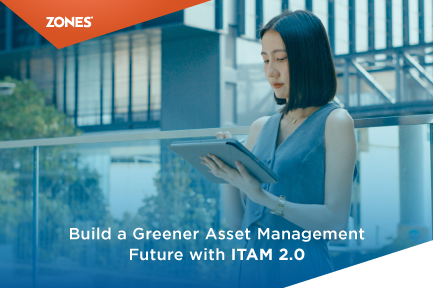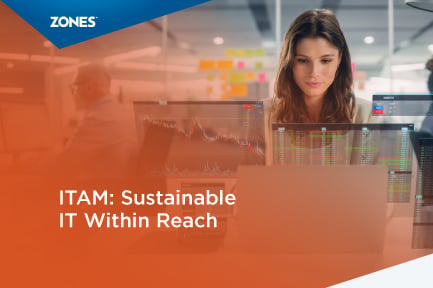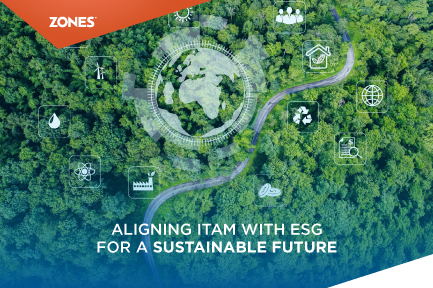10 Ways to Drive Sustainable IT with IT Asset Management (ITAM)
Climate change and environmental issues are major global challenges. This is why there is a growing recognition to mitigate the environmental impact...
5 min read
Gerry Doherty : Apr 22, 2025 12:45:19 PM

The management of IT assets has undergone a significant transformation in recent years. What began as simple inventory tracking has evolved into a comprehensive approach addressing environmental sustainability alongside business objectives.
Before 2017, IT asset management was primarily concerned with tracking basic hardware and software inventory. This was the era of ITAM 1.0. The focus was on tracking hardware for accounting purposes and ensuring assets weren't lost or stolen. Environmental considerations were nearly non-existent, asset lifecycle planning was minimal, and integration with broader sustainability goals wasn't even on the radar.
This limited approach served businesses adequately when IT footprints were smaller and environmental concerns weren't as pressing. However, as organizations' technology dependencies grew exponentially and awareness of environmental issues increased, the shortcomings of ITAM 1.0 became increasingly apparent.
This is why IT asset management evolved to embrace sustainability with ITAM 2.0, representing a fundamental shift in how organizations approach their technology assets. It consists of:
ITAM 2.0 transforms a mundane operational function into a strategic advantage that addresses both bottom-line concerns and environmental responsibilities.
|
Also Read: Achieving Sustainability and ESG Excellence in IT: Zones’ Journey |
The transition to ITAM 2.0 isn't merely a nice-to-have upgrade—it's becoming a business necessity driven by powerful forces from multiple directions. Several key factors are driving the shift toward sustainable ITAM:

Increasingly stringent ESG reporting requirements, environmental regulations, and data protection laws such as the California Consumer Privacy Act (CCPA) and California Privacy Rights Act (CPRA) mandate better tracking and management of IT assets.
Rising energy costs, potential carbon taxes, and C-suite demands for IT cost transparency are pushing organizations to optimize their IT asset expenditures and usage.
Investors, customers, and boards now expect organizations to demonstrate sustainable IT operations with measurable metrics.
The growing e-waste crisis, expanding carbon footprints, and organizational commitments to sustainability are driving the need for responsible IT asset management.
|
Also Read: 10 Ways to Drive Sustainable IT with IT Asset Management (ITAM) |
Implementing sustainable ITAM practices delivers substantial advantages for both business operations and environmental impact. Organizations transitioning to ITAM 2.0 can realize multiple benefits across different dimensions.
Financial and operational advantages of ITAM 2.0 extend beyond simple cost savings. Organizations implementing sustainable practices find improvements across multiple business metrics and often discover new opportunities for optimization.
Environmental impacts of ITAM 2.0 directly address many of the most pressing ecological challenges related to technology. Through systematic management, organizations can significantly reduce their ecological footprint while maintaining technological capabilities.
Transforming your organization's approach to IT asset management requires a structured approach. Here are six essential steps to successfully implement ITAM 2.0:
Creating effective governance serves as the foundation for ITAM 2.0 success. This step involves developing the organizational structure and processes needed to oversee sustainable IT asset management across the enterprise.
The journey toward sustainable ITAM begins at the purchasing stage. Environmentally conscious procurement establishes the foundation for all subsequent asset management activities and significantly impacts overall sustainability performance.
|
Also Read: 5 Dos and Don'ts of Sustainable IT Sourcing and Vendor Selection |
A circular approach to IT asset management maximizes value recovery while minimizing environmental impact. This step transforms linear asset lifecycles into circular flows that keep equipment and materials in productive use for longer periods.
Prolonging the useful life of IT assets represents one of the most effective ways to reduce both costs and environmental impact. This step focuses on strategies that maximize the productive lifespan of technology investments.
Proper end-of-life management protects both data security and environmental integrity. This step ensures that when assets must be retired, they are handled in ways that protect sensitive information while minimizing waste.
Meeting evolving reporting requirements is essential in today's regulatory environment. This step creates the infrastructure needed to demonstrate compliance and quantify sustainability progress to stakeholders.

Begin your journey toward ITAM 2.0 by conducting a sustainability audit of your existing IT asset management practices. Identify key stakeholders across departments who will be critical to implementation success and form a cross-functional team to lead the initiative. Set clear, measurable sustainability goals that align with broader organizational objectives.
Consider partnering with ITAM service providers who have demonstrated sustainability credentials in areas where your organization may lack experience. Begin with pilot initiatives that can demonstrate quick wins and build momentum for broader implementation.
By embracing the principles of ITAM 2.0, organizations can transform their approach to technology assets. What was once simply an operational necessity becomes a strategic advantage that delivers both business value and environmental benefits in an increasingly sustainability-focused world.
Want to dive deeper into sustainable ITAM 2.0 implementation? Join our exclusive webinar "ITAM 2.0: Evolution Toward Sustainable IT Asset Management."
What you will learn:
Tuesday, April 22 at 9:30 PDT
Register now to secure your spot and take the first step toward transforming your IT asset management strategy.
For more information on implementing sustainable ITAM practices in your organization, contact Zones' at 800.248.9948.

Climate change and environmental issues are major global challenges. This is why there is a growing recognition to mitigate the environmental impact...

Today, businesses operating across different locations face unique challenges in IT asset management (ITAM) with respect to tracking and managing...

Today, organizations face increasing pressure to balance operational efficiency with environmental responsibility. Due to this, two key areas have...